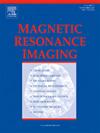快速肾脏MR指纹识别诊断慢性肾脏疾病的可行性研究
IF 2
4区 医学
Q2 RADIOLOGY, NUCLEAR MEDICINE & MEDICAL IMAGING
引用次数: 0
摘要
目的:本前瞻性研究的目的是探讨基于mrf的快速肾脏定量制图在慢性肾脏疾病(CKD)患者肾脏功能和微观结构特征无创评估中的可行性。方法:从2023年6月至2024年1月,前瞻性地招募同意肾脏MRF检查的CKD参与者。两个肾脏的肾皮质和髓质的T1和T2值来自人工划定的roi,并在CKD组之间进行比较。Spearman相关系数,在正态性检验之后,用于检验mrf衍生指标与血清肌酐(Scr)和测量的肾小球滤过率(mGFR)之间的关系。对于接受肾活检的参与者,使用双向方差分析来比较mrf衍生的活检肾脏指标与组织病理学结果。结果:纳入52例参与者(中位年龄49 岁[IQR, 39-59 岁]),其中42例接受肾活检。较高的CKD分期与皮质T1值升高相关(P 结论:MR指纹定量与肾功能和病理结果相关,并有望表征CKD状态。本文章由计算机程序翻译,如有差异,请以英文原文为准。
Rapid renal MR fingerprinting for characterizing chronic kidney disease: A feasibility study
Purpose
The aim of this prospective study was to investigate the feasibility of rapid renal MRF-based quantitative mapping for noninvasive assessment of renal functional and microstructural characteristics in patients with chronic kidney disease (CKD).
Methods
Participants with CKD who consented to renal MRF examination were prospectively enrolled from June 2023 to January 2024. T1 and T2 values of the renal cortex and medulla in both kidneys were derived from manually delineated ROIs and compared across CKD groups. Spearman correlation coefficients, following normality testing, were used to examine associations between MRF-derived metrics and serum creatinine (Scr) and measured glomerular filtration rate (mGFR). For participants who underwent renal biopsy, two-way ANOVA was used to compare MRF-derived metrics of biopsied kidney with histopathologic findings.
Results
Fifty-two participants (median age, 49 years [IQR, 39–59 years]) were included, of whom 42 underwent renal biopsy. Higher CKD stages were associated with increased cortical T1 values (P < .001 for the left kidney, P < .0001 for the right kidney, at one-way ANOVA) and higher medullary T2 values (P < .001 for the left kidney, P < .01 for the right kidney, at one-way ANOVA). Scr and mGFR were well correlated with cortical-medullary T1 difference (△T1) of the left kidney (r = −0.543, P = .0004; r = 0.657, P < .0001, respectively). Renal MRF-derived cortical T1, △T1, and whole-kidney T1 showed difference between the low-grade and high-grade renal fibrosis groups (15 % and 20 % fibrosis thresholds, P = .040; 15 % and 30 % fibrosis thresholds, P = .046; and 20 % fibrosis threshold, P = .0264, at two-way ANOVA).
Conclusion
MR Fingerprinting quantitation correlated well with the renal functional and pathological findings, and demonstrated promise for characterizing CKD status.
求助全文
通过发布文献求助,成功后即可免费获取论文全文。
去求助
来源期刊

Magnetic resonance imaging
医学-核医学
CiteScore
4.70
自引率
4.00%
发文量
194
审稿时长
83 days
期刊介绍:
Magnetic Resonance Imaging (MRI) is the first international multidisciplinary journal encompassing physical, life, and clinical science investigations as they relate to the development and use of magnetic resonance imaging. MRI is dedicated to both basic research, technological innovation and applications, providing a single forum for communication among radiologists, physicists, chemists, biochemists, biologists, engineers, internists, pathologists, physiologists, computer scientists, and mathematicians.
 求助内容:
求助内容: 应助结果提醒方式:
应助结果提醒方式:


